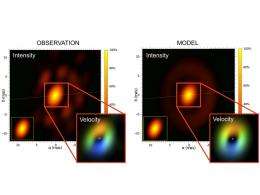Supergiant star with a thick dust disc

How is it possible that HD 62623, a hot super-giant star on the verge of death, is surrounded by a disc, generally only associated with infant stars? Using long-baseline stellar interferometry at ESO's VLT interferometer, a team led by Florentin Millour from Observatoire de la Cote d'Azur and Anthony Meilland from Max Planck Institute for Radio Astronomy could generate for the first time a three-dimensional high angular and high spectral resolution image of this star and its closest environment. They conclude that a solar-mass companion star is the key to this mystery. To attain their goal, the researchers adapted an imaging technique from radio astronomy which uses interferometric datasets.
HD 62623 is an exotic hot supergiant star. Contrary to its well-known twin, the bright star Deneb in the summer triangle, and almost all stars with the same spectral class, this star is surrounded by a dense and complex zone composed of plasma and dust. Hot supergiant stars are very bright stars, so bright, that they push their strong wind with their own photons. Such a wind would normally prevent matter from condensing as dust next to the star. So as to understand dust formation processes in the harsh environment of such stars better, it is highly desirable to disentangle the geometry of the gas and dust in the surroundings of the central source, but also to access the kinematics of this close environment.
"Thanks to our interferometric observations with AMBER we could synthesize a 3D image of HD 62623 as seen through a virtual 130 metre diameter telescope", says Florentin Millour, leading author of the study. "The resolution is of an order of magnitude higher when compared with the world's largest optical telescopes of 8-10 metres diameter." The AMBER instrument is located at the Very Large Telescope Interferometer (VLTI) in Chile. The scientists significantly improved the image quality by adapting the so-called "self-calibration" method, which is well-known from radio interferometry. The image obtained by this method combines spatial and velocity information, showing not only the shape of the close environment of HD 62623, but also its kinematics or motion. Up until now the necessary kinematics information was missing in such images.

"Our new 3D image locates the dust-forming region around HD 62623 very precisely, and it provides evidence for the rotation of the gas around the central star," explains Anthony Meilland. "This rotation is found to be Keplerian, the same way the Solar system planets rotate around the Sun." A nearby companion star, with approximately the mass of our Sun, could be the reason for such a disc around HD 62623. This companion, though not directly detected due to its brightness being thousands of times lower than the primary star, is betrayed by a central cavity between the gas disk and the central star. The presence of the companion could explain the exotic characteristics of HD 62623, exactly like the monster among the old stars within our Galaxy, Eta Carinae.
The new 3D imaging technique presented in this work is equivalent to integral-field spectroscopy, but gives access to a 15 times larger angular resolution or capacity to detect fine details in the images. "With these new capacities, the VLTI will be able to provide a better comprehension of many sky targets, too small to be resolved by the largest telescopes", concludes Florentin Millour. "We can use this approach to study young stellar disks or jets, or even the central regions of active galaxies."
The European Southern Observatory (ESO): is the foremost intergovernmental astronomy organisation in Europe and the world's most productive astronomical observatory. It is supported by 14 countries: Austria, Belgium, the Czech Republic, Denmark, France, Finland, Germany, Italy, the Netherlands, Portugal, Spain, Sweden, Switzerland and the United Kingdom. ESO operates three unique world-class observing sites in Chile: La Silla, Paranal and Chajnantor.
The Very Large Telescope Interferometer (VLTI): utilizes telescopes at ESO's Paranal site, either the 8.2 m UTs or the 1.8m ATs (Auxiliary Telescopes). AMBER (Astronomical Multi-BEam Recombiner) is one of the science instruments of the VLTI. It is an interferometric beam combiner, sensitive in the near-infrared wavelength range (from 1 to 2.5 microns), built in collaboration with institutes from Grenoble (Laboratoire d'Astrophysique de Grenoble), Nice (Laboratoire d'Astrophysique Universitaire de Nice und Observatoire de la Côte d'Azur), Florence (Observatorio Astrofisico di Arcetri) and Bonn (Max Planck Institute for Radio Astronomy).
More information: Florentin Millour, et al. Imaging the spinning gas and dust in the disc around the supergiant A[e] star HD62623, Astronomy & Astrophysics, DOI:10.1051/0004-6361/201016193 , 26. January 2011
Provided by Max-Planck-Gesellschaft



















